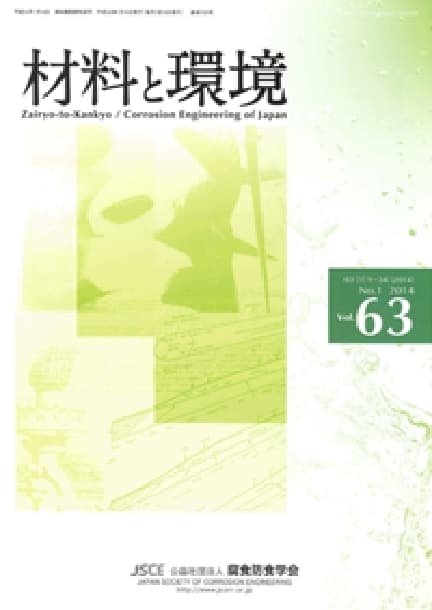- TOP
- Zairyo-to-Kankyo
- Vol. 64 (2015), No. 4
Zairyo-to-Kankyo Vol. 64 (2015), No. 4
Backnumber
-
Vol. 74 (2025)
-
Vol. 73 (2024)
-
Vol. 72 (2023)
-
Vol. 71 (2022)
-
Vol. 70 (2021)
-
Vol. 69 (2020)
-
Vol. 68 (2019)
-
Vol. 67 (2018)
-
Vol. 66 (2017)
-
Vol. 65 (2016)
-
Vol. 64 (2015)
-
Vol. 63 (2014)
-
Vol. 62 (2013)
-
Vol. 61 (2012)
-
Vol. 60 (2011)
-
Vol. 59 (2010)
-
Vol. 58 (2009)
-
Vol. 57 (2008)
-
Vol. 56 (2007)
-
Vol. 55 (2006)
-
Vol. 54 (2005)
-
Vol. 53 (2004)
-
Vol. 52 (2003)
-
Vol. 51 (2002)
-
Vol. 50 (2001)
-
Vol. 49 (2000)
-
Vol. 48 (1999)
-
Vol. 47 (1998)
-
Vol. 46 (1997)
-
Vol. 45 (1996)
-
Vol. 44 (1995)
-
Vol. 43 (1994)
-
Vol. 42 (1993)
-
Vol. 41 (1992)
-
Vol. 40 (1991)
Keyword Ranking
15 Dec. (Last 30 Days)
Zairyo-to-Kankyo Vol. 64 (2015), No. 4
Development of Environmentally Acceptable Technology for Cooling Water Treatment
Shinichi Takasaki
pp. 114-120
DOI:
10.3323/jcorr.64.114Abstract
The technology of non-toxic corrosion inhibitors developed as a replacement of chromate in cooling water treatment was reviewed. Polyphosphate and phosphonate react with mother metal ion to form a protective film at anodic sites. On the other hand they form a protective film by precipitation with zinc ions and / or calcium ions at cathodic sites depending on their concentration. Acryl acid based polymer or maleic acid based polymer used as scale inhibitor enhances the effectiveness of cathodic inhibitors for carbon steel, and also made possible to increase the cycle number of concentration in cooling water and to decrease the total amount of phosphate in effluent water. The developments of green inhibitors, scale inhibitors for silica scale, non-chemical water treatment devices, and so on are expected in future.
High-temperature Corrosion Behavior of Heat-resistant Cast Alloys in a Low-grade Fuel Firing Boiler Ash Environment
Osamu Takahashi, Yuhua Su, Yo Tomota
pp. 132-138
DOI:
10.3323/jcorr.64.132Abstract
In industrial boilers that use low-grade fuel, high-temperature sulfidation corrosion and vanadium attack have been major issues. High-temperature corrosion tests using actual boiler ash were performed for six heat-resistant cast alloys as candidate materials for burner chips and swirlers. At 850°C, corrosion was not sever, and SCH2 and 50Cr50Ni exhibited particularly good corrosion resistance. However, at 1050°C, corrosion weight loss of 50Cr50Ni, 30Cr70Ni, SCH13, and SCH22 dramatically increased, whereas that of 60Cr40Ni and Ni-less SCH2 was relatively small. Such corrosion mechanisms are discussed on the basis of microstructure observations and the results of EBSD and EDX analyses.
Comparison of Photo Degradation Behavior of LDPE using Accelerated Weathering Instruments
Takashi Miwa, Yukitoshi Takeshita, Yuichi Akage, Masamitsu Watanabe, Masaaki Takaya, Takashi Sawada
pp. 139-144
DOI:
10.3323/jcorr.64.139Abstract
Samples of low-density polyethylene (LDPE) were photodegraded using accelerated weathering instruments and outdoor exposure. The physical properties and chemical structures of the photodegraded samples were studied through a tensile test, gel chromatography, and infrared spectroscopy. The molecular weight distribution of a photodegraded sample by using a fluorescent UV lamp at a high black panel temperature (80°C) was more similar to that of an outdoor-degraded sample than that of other artificially photodegraded samples by using a Xenon lamp at the standard black panel temperature (63°C). It is estimated that accelerated weathering tests at a high sample temperature could accelerate cross-linking than chain scission, consequently recreating molecule-enlargement similar to the outdoor-degraded sample.
Article Access Ranking
15 Dec. (Last 30 Days)
-
Delayed Fracture Mechanism of 1700 MPa-Class Quenched and Tempered Bolt under Atmospheric Corrosion Environment
Tetsu-to-Hagané Advance Publication
-
Perspectives on the Promising Pathways to Zero Carbon Emissions in the Steel Industry toward 2050
ISIJ International Vol.65(2025), No.2
-
Effect of B on Surface Oxidation Behavior and Phosphatability of Si-Mn-added Cold-Rolled Steel Sheets
ISIJ International Advance Publication
-
Factors Influencing the Bonding Phase Structure of Iron Ore Sinters
ISIJ International Vol.43(2003), No.9
-
Effect of microstructural heterogeneity on fatigue limit of as-quenched low-carbon low-alloy martensitic steel
ISIJ International Advance Publication
-
Prussian blue as a fully reversible hydrogenochromic material for visualizing hydrogen distribution in Fe sheet
ISIJ International Advance Publication
-
Progress of Strip Casting Technology for Steel; Historical Developments
ISIJ International Vol.52(2012), No.12
-
Research Progress on Optimal Blending of Iron Ore Powders for Sintering
ISIJ International Vol.65(2025), No.12
-
-
Microstructures and Reduction Properties of High CaO Concentration Sintered Ore
ISIJ International Advance Publication
You can use this feature after you logged into the site.
Please click the button below.










